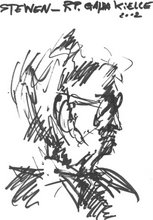The occasion was Sunday's annual Warsaw Jewish Festival. We have been once before, but this was an occasion to let Misia see how Jews contributed to Warsaw life. I don't know about Misia, but the festival completely failed to help me in this, but it was an opportunity for Basia to tell her how important the Jewish contribution was.
The festival is held in a small street of derelict tenements.
 |
| From 2010 09 |

Whilst the dereliction may be fine as a memorial to those dead and gone, it gives no indication to me of the way that Jews used to live here. It is within the Warsaw ghetto area, but I don't even know if it looks anything like it looked then. Why derelict - surely it can't stay that way? Someone told me, or perhaps we speculated, that there may be difficulties with agreeing the ownership. However, even if not, what could be done with the buildings to retain them as a reminder to Jewish life and death?

If renovated, they would probably look no different to many other Warsaw terrace blocks. The shops below might be smaller than normal, but would there be any reason for a Jewish flavour to be retained? Although I assume that some of the people at the festival were Jewish, most of the people selling things could easily have been Polish for all I know. Even Basia, on whom I can normally rely to have a good idea about Jewish faces, only said that she particularly noticed one Jew. The occasion was largely a street market with only a partial Jewish character. There was music and dancing on two stages, but this modern style representation of traditional Jewish culture does nothing to impress on me the way life was. Indeed, the 20 or so people dancing on the stage showed such little rhythm and real enthusiasm that they didn't even give the impression of being a not-particularly-good, group of Jewish amateurs. Mind you, since I am interested in the extent to which Jewish life might have been distinguishable from Polish life, perhaps I am approaching the whole thing from the wrong perspective - the assumption that there was a difference.
One picture did catch my eye in the corner of a shop that was largely selling reprints of original French prints - presumably Jews. It was too far away to see clearly, but it looked old and seemed to show a man, I presumed a Jew, in the corner of a well-furnished room. Since many Jews were affluent, I thought this might give me a better idea of their past. My photograph was disappointing: nice painting though.

We did go into the synagogue, although the inside gave the general impression of a normal meeting place. It did remind me of some English Quaker halls in style, but without the beauty of their wood based decoration.

It has a fine front, but, apart from the Star of David, is not exceptional as a Warsaw building.

Perhaps what impressed me most was an indication of the closeness of Jewish and Christian lives in Warsaw, when looking from the steps of All Saint's Church across the building site where the square is being renovated. The statue of Pope John Paul neither looking away from, nor at the Jewish street.

Then we went to the Old Town and had lunch in the Maharaja Thai Restaurant, our regular eating place.



No comments:
Post a Comment